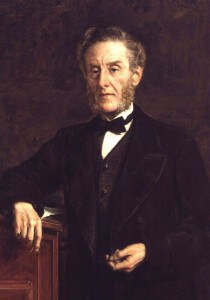Kids Today: The Generation Gap
By Alice Askins, Education Coordinator at Rose Hill Mansion

Anti-war protest by Hobart and William Smith students and faculty at the Geneva Armory in 1969
In the 1960s, a new phrase came into use: the generation gap. As Wikipedia describes it, “. . . the younger generation (later known as Baby Boomers) seemed to go against everything their parents had previously believed . . . .” Discord between older and younger did not suddenly appear from nowhere. There is evidence of concern earlier, for example in the Geneva Times of January 11, 1958, when Vivian Kidd complained, “The young generation of today is lacking in manners.” In the 1960s, though, there was a sense of urgency about the issue. It may have seemed more alarming to parents because there were so many of the younger generation. And in fact, some things were different, or on a larger scale than before – kids’ social and political activism, with the threat of violence about it, was especially upsetting. So was the possibility of your child using illegal drugs, with a range of consequences.
The Times reflected the general uneasiness, usually from the point of view of the older generation. In February 1963, for example, there was an announcement that Bernard Brosius (a guidance counselor at Geneva Junior High) would be telling the Kiwanians how to “Know Your Teen-Ager Better.” District Principal of Phelps and Clifton Springs, John Fahy, spoke in March 1969 on whether the “Generation Gap” should become a “Generation Gulf.” He appeared before the North Street Home and School Association to discuss “declining family relations and [in] general the disorder of society.” Also in 1969, the paper ran a series of articles intended to help parents safeguard their teenagers from drugs.

Cartoon from the Geneva Times, October 1968
Coverage of the generational issue was often humorous. In June 1969, the paper printed a piece by columnist Art Buchwald. Mr Buchwald was responding to activist Ralph Nader’s concerns about the noise levels of rock and roll music, and its potential for hearing damage:
No one has more admiration for Ralph Nader than I do, but I believe he bit off more than he could chew . . . It’s one thing to take on General Motors, but when you start messing with teenagers’ tastes in music, you’re really in a hornet’s nest. . . . while rock n’ roll may play a part in the impairment of hearing, parents play a bigger part. Almost anything a parent says to a teen-ager falls on blocked ears.
Harriet Van Horne, a columnist based in New York, wrote in February 1969 that spanning the generation gap was tricky:
. . . At times it’s like crawling across a swaying footbridge in the Andes – the ropes can snap at any moment. And in the back of one’s mind, always the question . . . is there really anything of consequence on the other side? . . . on the other side, as strange sometimes as creatures from outer space, stand the young, the children in whom we have invested all our dreams of good. In general, they’re a fine, idealistic lot, though they dress hideously and obviously trim each other’s locks with the hedge clippers. . . .
There was deep concern, though, about the way youth seemed to be going. On September 3, 1969, the Times printed an article by James E. Clayton of the Washington Post. He was appalled by the FBI’s annual report on crime in the US:
. . . almost half . . . of all persons charged with committing a major crime in 1968 was a juvenile . . . a quarter of those arrested for major thefts were not yet 15 . . . the number of juveniles arrested for all offenses (except traffic) has doubled since 1960 while the number of adults arrested has increased by only 4 per cent . . . there was one arrest of a teen-ager last year for every 16 in the nation. . . . Crime rates went up as much in the suburbs as they did in the cities last year and the percentage of juveniles among those charged with serious crimes is somewhat higher in the suburbs than in the cities.
Many threw up their hands. As a local woman put it, in a letter to the editor in July 1970:
. . . when I see these unkept [sic] students about the city, many camouflaged in long hair and beards, I look at them in wonderment. We read stories and see movies about invasion by creatures from space. Invade us? They already have! And they would destroy our country as surely as any monster, altering our life style to suit themselves.
For all of us who have worried about the future of humanity, there is some possible comfort. Socrates wrote: “The children now love luxury. They have bad manners, contempt for authority; they show disrespect for elders and love chatter in place of exercise.” He was later executed for having allegedly corrupted the youth of Athens and offended against the Greek religion.
In his 1624 book The Wise-Man’s Forecast against the Evill Time, the clergyman Thomas Barnes complained, “Youth were never more sawcie, yea never more savagely saucie . . . the ancient are scorned, the honourable are contemned, the magistrate is not dreaded.”

Anthony Ashley Cooper, 7th Earl of Shaftesbury
During a speech to the House of Commons in 1843, Anthony Ashley Cooper, the 7th Earl of Shaftesbury, exclaimed against
. . . a fearful multitude of untutored savages… [boys] with dogs at their heels and other evidence of dissolute habits…[girls who] drive coal-carts, ride astride upon horses, drink, swear, fight, smoke, whistle, and care for nobody . . . the morals of children are tenfold worse than formerly.
In 1904, psychologist Granville Stanley Hall published The Psychology of Adolescence, in which he warned that the 20th century was a dangerous time:
Never has youth been exposed to such dangers of both perversion and arrest as in our own land and day. Increasing urban life with its temptations . . . a lessening sense for both duty and discipline . . . the mad rush for sudden wealth and the reckless fashions set by its gilded youth–all these lack some of the regulatives they still have in older lands with more conservative conditions.
 Over the centuries we have attributed the perceived degeneration of our youth to such causes as waltzing, chess, urbanization, movies, rock and roll, drugs, television, and the internet. We have despaired of the future. Yet here we still are. Let us think about Socrates, and trust that 2000 years from now, our descendants will still be here, worrying about their kids.
Over the centuries we have attributed the perceived degeneration of our youth to such causes as waltzing, chess, urbanization, movies, rock and roll, drugs, television, and the internet. We have despaired of the future. Yet here we still are. Let us think about Socrates, and trust that 2000 years from now, our descendants will still be here, worrying about their kids.
